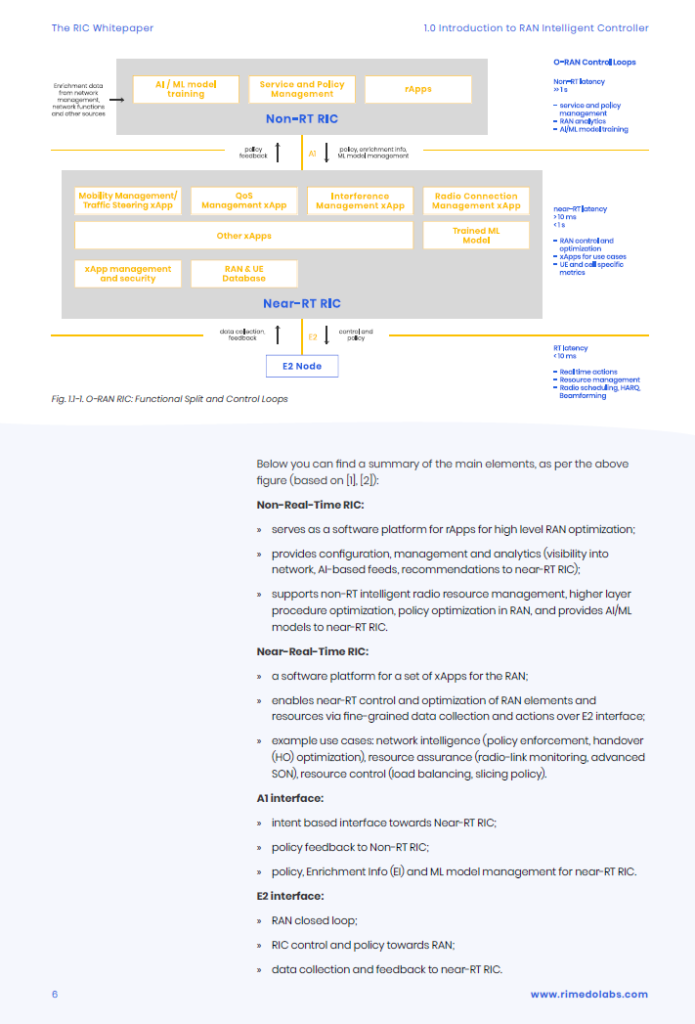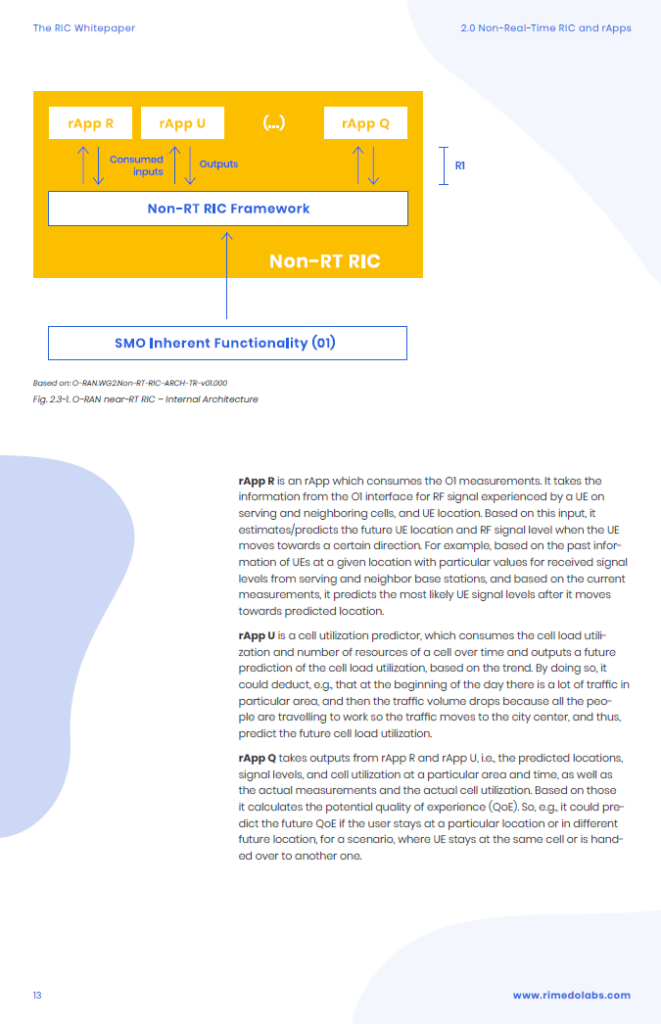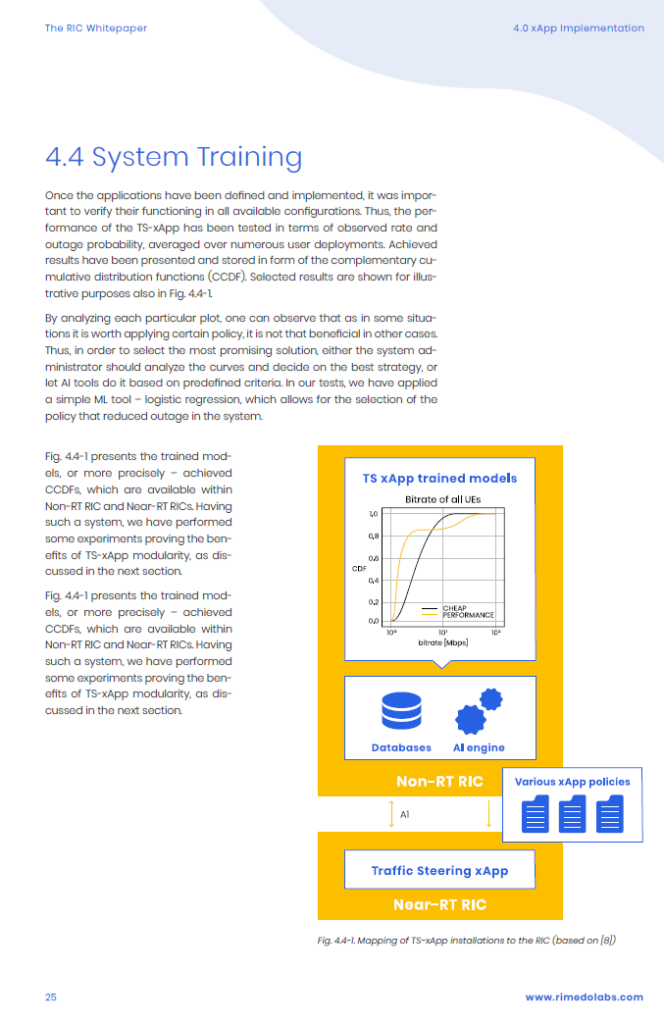„The O-RAN Whitepaper 2022 – RAN Intelligent Controller”
Similarly, to last year, we are pleased to introduce our latest The O-RAN Whitepaper 2022 (RAN Intelligent Controller). This post is dedicated to revealing some contents of the whitepaper.
Introduction
This whitepaper provides the technical discussion of one of the key components in the Open Radio Access Network (Open RAN) architecture as defined by O-RAN Alliance, i.e., RAN Intelligent Controller (RIC). RIC serves as a platform for the optimization of the radio network and radio resources and is split into Non-Real-Time RIC (Non-RT RIC), operating in the management plane, and Near-RT RIC, operating in the RAN domain. The names refer to the timescale of operation, Non-RT RIC operates in the range of minutes or hours, while Near-RT RIC operates within tens or hundreds of milliseconds. Both RICs use external applications, called rApps and xApps respectively serving as tailored algorithms for certain use cases, including radio resource management (RRM) and self-organizing networks (SON) functionalities.
First, the concept of RIC is described, together with its functional split and three control loops in the O-RAN architecture. This is accompanied by the comparison between xApps and rApps. The first chapter serves as a starting point for more details to be provided in the following parts.
Later, the whitepaper discusses the Non-RT RIC, its architecture within Service Management and Orchestration (SMO), along exemplary rApps. The discussion focuses on a specific application, for the Quality-of-Experience (QoE) prediction, where three rApps provide input for creating policies for resource optimization.
Next, the details of Near-RT RIC are addressed, which provides the possibility to manage the radio resources on a near-real-time basis using xApps. The architecture of Near-RT RIC is discussed, together with the accompanied open interface, E2, and one of the service model types, namely Key Performance Measurements (KPM).
The final part of the whitepaper provides the description of an xApp implementation example for the use case of traffic steering. The scenario setup, use case, machine learning (ML) model training, and simulation results are discussed.
The whitepaper ends with a summary and conclusions section along with a glossary of the O-RAN terms.
Cite this: M. Dryjanski, A. Kliks, „The O-RAN Whitepaper 2022 – RAN Intelligent Controller”, Whitepaper, Rimedo Labs, Feb 2022
The O-RAN Whitepaper Contents
1.0 Introduction to RAN Intelligent Controller

RAN Intelligent Controller (RIC) is defined within the O-RAN architecture as an entity hosting part of functionality from the eNB or gNB that was traditionally located at the base station. The functions, to which we relate here in the RAN domain include e.g., mobility management or interference management. The decisions are made in the xApps, and RIC then enforces policies towards the RAN elements and controls them using the open interface, namely E2. In this chapter, we elaborate on the RIC and its functional split, xApps, and rApps.
- 1.1 RAN Intelligent Controller
- 1.2 Control Loops
- 1.3 xApps and rApps
Chapter 2.0 Non-Real-Time RIC and rApps

The goal of Non-Real Time RAN Intelligent Controller (O-RAN Non-RT RIC) is to support intelligent RAN optimization by providing policy-based guidance, model management, and enrichment information (EI) to the Near-RT RIC function so that RAN can be optimized. In contrary to Near-RT RIC, which sits in the RAN domain and works on a timescale of tens to hundreds of milliseconds, Non-RT RIC works within the management plane (and more particularly in Service Management and Orchestration, SMO) and operates on a timescale of seconds and minutes. In this chapter, the architecture of the Non-RT RIC is provided and the example applications, called rApps, are discussed.
- 2.1 Non-RT RIC
- 2.2 Non-RT RIC Architecture
- 2.3 rApp Examples
Chapter 3.0 Near-Real-Time RIC

RAN Intelligent Controller (RIC), provides the possibility to manage the radio resources and radio network and is designed within O-RAN architecture as a separate entity. As was explained in the previous parts of the whitepaper, RIC is split into near-Real-Time RIC (O-RAN near-RT RIC) and Non-Real-Time RIC. In this chapter, the former option will be discussed.
- 3.1 Near-RT RIC
- 3.2 Near-RT RIC Implementation Options
- 3.3 Near-RT RIC Deployment Flexibility
- 3.4 E2 Interface
Chapter 4.0 xApp Implementation

The focus of this chapter is the implementation of an xApp tailored for the traffic steering use case. The goal of this xApp is to support the network providers to reassign the traffic from one base station to the other in order to meet some predefined criteria (like link quality maximization, throughput maximization). Some initial results will be shown, that highlight the great opportunity offered by O-RAN. The operator can easily install, modify or remove the xApp when needed. It simply depends on the needs.
- 4.1 Traffic Steering Use Case Analysis
- 4.2 Considered Network Setup
- 4.3 xApp Implementation: O-RAN Traffic Steering Use Case
- 4.4 System Training
- 4.5 Simulation Results
Summary and conclusions
RAN Intelligent Controller serves as a platform for the optimization of a radio network and radio resources and is split into Non-RT RIC, operating in the management plane, and Near-RT RIC, operating in the RAN domain. They are accompanied by rApps and xApps respectively, which serve as tailored algorithms for certain use cases including RRM and SON functions.
In this whitepaper, the authors provided an introduction to the RIC and showed basic information such as the functional split of the RIC, the basic building blocks, as well as control loops, and provided a comparison between xApps and rApps.
Having in mind the discussion from chapter 2.0 regarding the three rApps, the RAN operation can be optimized as follows. Based on the operation and outputs of the rApps, the policy is created to be sent down to the Near-RT RIC, for example, defining that a particular user is going to have that particular QoE if it stays in a particular cell. If it’s not a satisfying QoE, the user should rather be moved to another cell to make sure that the QoE is assured in the near future. All this is prepared based on previous experience, actual situation, and contextual information. Using those policies, the Near-RT RIC (or rather an xApp within Near-RT RIC) decides on actual actions to happen in the RAN elements.
Later in the paper, chapter 3.0 discusses near-RT RIC as one of the key elements in the O-RAN architecture, which allows feeding an „external” intelligence into the operations of the radio network. It creates a platform on which the vendors (either software vendors or telco vendors or xApp developers) could provide per-use case RRM algorithms to allow adaptation/optimization radio resources usage for specific scenarios. It will be interesting to see how the creation of the ecosystem for those applications will play out. Will there be Google Plays and App Stores for the telco world?
Summarizing the results from chapter 4.0, one can observe that the opportunity to install/uninstall the xApp/rApp jointly with the tailored way for selecting the best policy, provides the O-RAN operator with promising ways to improve the network performance depending on its (current) needs. The software modularity allows for fast adjustment of the network functioning thus leading to efficiency increase.
The overall conclusions from this whitepaper are as follows:
- adding intelligence to the radio network is allowed via RIC (using xApps and rApps);
- using Non-RT RIC allows to control the RAN behavior by declarative policies;
- combination of various applications (like xApps/rApps) allows to realize certain objectives for network performance optimization;
- a hierarchical and modular approach to resource management is possible by separating the concerns with regards to timescale of operation and placement of the RICs;
- it is possible to define RRM/SON applications (xApps/rApps) on per use case basis.
References
[1] O-RAN ALLIANCE (o-ran.org)
[2] O-RAN.WG1.O RAN Architecture Description v03.00, “O-RAN Architecture Description”, O-RAN Alliance
[3] O-RAN.WG2.Non-RT-RIC-ARCH-TR-v01.00, „Non-RT RIC Architecture”, O-RAN Alliance
[4] O-RAN.WG3.RICARCH-v02.00, „Near-Real-time RAN Intelligent Controller (Near-RT RIC) Architecture”, O-RAN Alliance
[5] O-RAN.WG3.E2GAP-v01.01, „Near-Real-time RAN Intelligent Controller Architecture & E2 General Aspects and Principles”, O-RAN Alliance
[6] ORAN-WG3.E2SM-KPM-v01.00.00, „O-RAN Near-Real-time RAN Intelligent Controller E2 Service Model (E2SM) KPM”, O-RAN Alliance, February 2020
[7] X. Xu, C. Yuan, W. Chen, X. Tao, and Y. Sun, „Adaptive Cell Zooming and Sleeping for Green Heterogeneous Ultradense Networks,” IEEE Transactions on Vehicular Technology, vol. 67, no. 2, pp. 1612-1621, Feb. 2018.
[8] Dryjański, M.; Kułacz, Ł.; Kliks, A. Toward Modular and Flexible Open RAN Implementations in 6G Networks: Traffic Steering Use Case and O-RAN xApps. Sensors 2021, 21, 8173. https://www.mdpi.com/1424-8220/21/24/8173
To download the Whitepaper, go to The O-RAN Whitepaper 2022 (RAN Intelligent Controller)
Other Resources from Rimedo Labs
- The previous whitepaper: The O-RAN Whitepaper 2021 (mailchi.mp)
- To check our blog posts on #AllThingsWireless, visit: Blog – RIMEDO Labs
- Webinar: A video recording from an O-RAN Webinar: O-RAN Architecture and Use Cases – YouTube
- To download the slides from the O-RAN Webinar, visit: slides on O-RAN Architecture and Use Cases
- Training: Sign up for our O-RAN System Overview Course.
- Poster (High quality, printer-friendly, A3): Subscribe to get your O-RAN Poster copy.
Author Bio
Marcin Dryjanski received his Ph.D. (with distinction) from the Poznan University of Technology in September 2019. Over the past 12 years, Marcin served as an R&D engineer and consultant, technical trainer, technical leader, advisor, and board member. Marcin has been involved in 5G design since 2012 when he was a work-package leader in the FP7 5GNOW project. Since 2018, he is a Senior IEEE Member. He is a co-author of many articles on 5G and LTE-Advanced Pro and a co-author of the book „From LTE to LTE-Advanced Pro and 5G” (M. Rahnema, M. Dryjanski, Artech House 2017). From October 2014 to October 2017, he was an external advisor at Huawei Technologies Sweden AB, working on algorithms and architecture of the RAN network for LTE-Advanced Pro and 5G systems. Marcin is a co-founder of Grandmetric, where he served as a board member and wireless architect between 2015 and 2020. Currently, he serves as CEO and principal consultant at Rimedo Labs.
